Palazzi di Campidoglio (original) (raw)
 Palazzi del Campidoglio - page one
(Vasi at work in the Grand View of Rome)
Palazzi del Campidoglio - page one
(Vasi at work in the Grand View of Rome)
Links to this page can be found in Book 4, Map B3, Day 1, View C8 and Rione Campitelli.
The page covers: [The plate by Giuseppe Vasi](#The Plate) Today's view Palazzi del Campidoglio: [Senatorio](#The Palaces), dei Conservatori and Nuovo [Ancient Statues](#The Statues) Palazzo Caffarelli Tempio di Giove Capitolino and Triade Capitolina Uffici delle Corporazioni Palazzetto Altemps [Rupe Tarpea](#Rupe Tarpea) in a second page: Inside Palazzo dei Conservatori Inside the Epigraphic Gallery Inside Palazzo Nuovo
#### The Plate (No. 80)
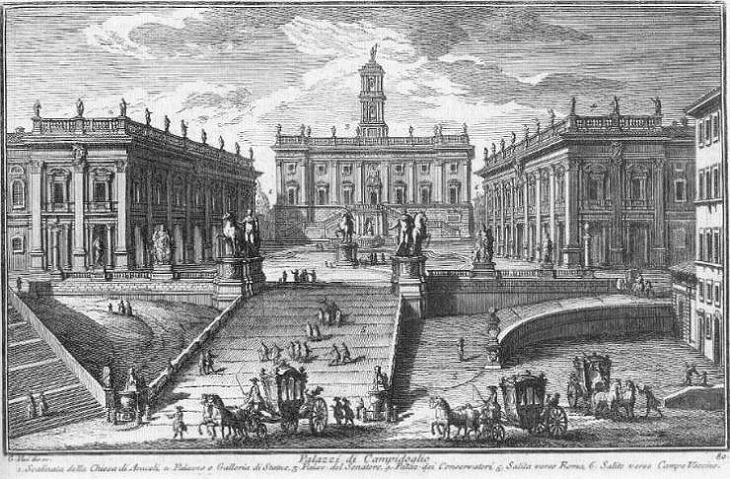
In 1754 Giuseppe Vasi opened his book of etchings covering the Palaces of Rome with a view of [Palazzo Pontificio al Quirinale](Vasi61.html#The Plate), at the time the residence of the Popes, and closed it with a view of Palazzi di Campidoglio, which housed the offices of the lay municipal authorities of Rome. In order to show all the details of the palaces Vasi structured his view around the ramp leading to them, while many other etchers and painters showed it in conjunction with the steps leading to S. Maria in Aracoeli (you may wish to see the etching by Giovanni Battista Piranesi - it opens in another window). The view is taken from the green dot in the small 1748 map here below. In the description below the plate Vasi made reference to: 1) Steps leading to S. Maria in Aracoeli; 2) Palazzo Nuovo; 3) Palazzo Senatorio; 4) Palazzo dei Conservatori; 5) Ramp towards (the centre of) Rome; 6) Steps from Campo Vaccino. The small map shows also 7) Palazzo Caffarelli; 8) Palazzetto Altemps; 9) Rupe Tarpea.

#### Today

## The view in June 2010 including the full view of the steps leading to S. Maria in Aracoeli (in the upper left corner the lift to Terrazza delle Quadrighe)
In the XVIIIth century houses and other buildings surrounded Palazzi di Campidoglio and S. Maria in Aracoeli, but today the two monuments are isolated from the rest of the city (apart from the bulky mass of [Monumento a Vittorio Emanuele II](Vasi65.htm#Monument to Victor Emmanuel)). Changes started during the [French administration of Rome](Storia28.html#French Empire) at the beginning of the XIXth century and ended in 1930 with the pulling down of a neighbourhood at the foot of the hill.
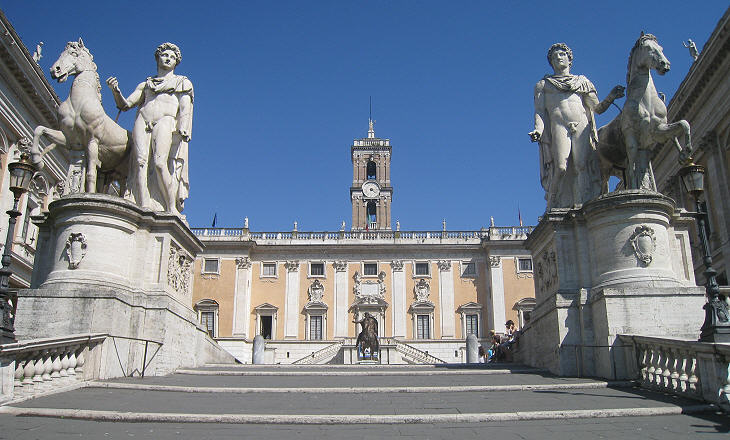
## View taken from near the top of the ramp
The genius of Michael Angelo was employed to make the ancient citadel not only accessible, but inviting. The broad and easy ascent, the fa�ade and steps of the senatorial palace; the lateral edifices, have accomplished this object; but they accord ill with our preconceptions of the Roman Capitol. (..) As, however, the stranger cannot have the satisfaction of climbing the Capitol by the ancient triumphal road, whose exact position has not been ascertained, he should pay his first visit on the other side, by the modern approach, where the colossal figures and the trophies of Marius in front, and the equestrian Aurelius rising before him as he mounts, have an air of ancient grandeur suitable to the sensations inspired by the genius of the place. John Cam Hobhouse - Dissertations on the Ruins of Rome - 1818 Changes to Piazza del Campidoglio and its palaces are very limited and they all relate to Palazzo Senatorio: a) in 1806 a clock on the fa�ade of S. Maria in Aracoeli was relocated to the tower of the palace; b) a coat of arms of [Pope Clement VIII](Storia23.html#Clement VIII) above a 1598 inscription celebrating the completion of the new fa�ade was removed after 1870 and in 1890 coats of arms of the Kingdom of Italy and of the City of Rome were placed at the sides of the inscription.
#### Palazzi del Campidoglio
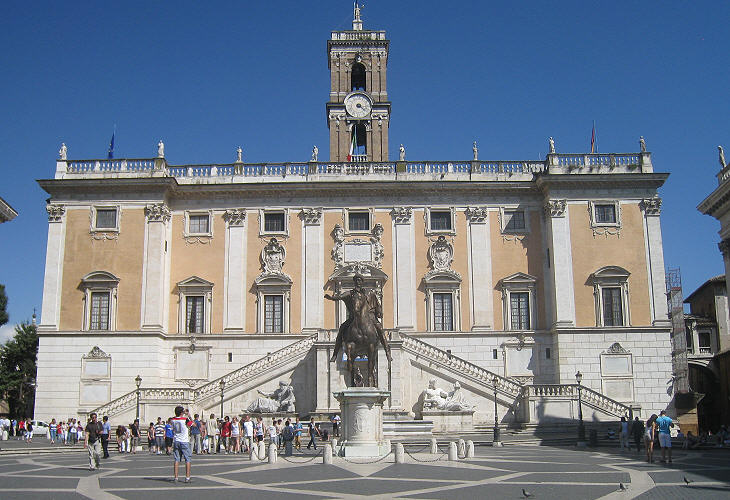
## Palazzo Senatorio and copy of the statue of Emperor Marcus Aurelius. The original is inside Palazzo dei Conservatori
The Senate of Ancient Rome was housed in Curia Julia in the Forum; the building was turned into a church in the VIIth century; in 1143, in the frame of attempts to form a municipal power in Rome, the ancient institution was revived; a Senate composed of some 50 members met in the medieval fortifications of Campidoglio above the Tabularium, an ancient building which housed the tabulae, the laws of Rome. The choice of this location was no doubt linked to the historical relevance of the site, but it had also a practical purpose: it was easily defensible and in 1145 Pope Lucius II was killed while leading an attack against the Senators and their supporters.
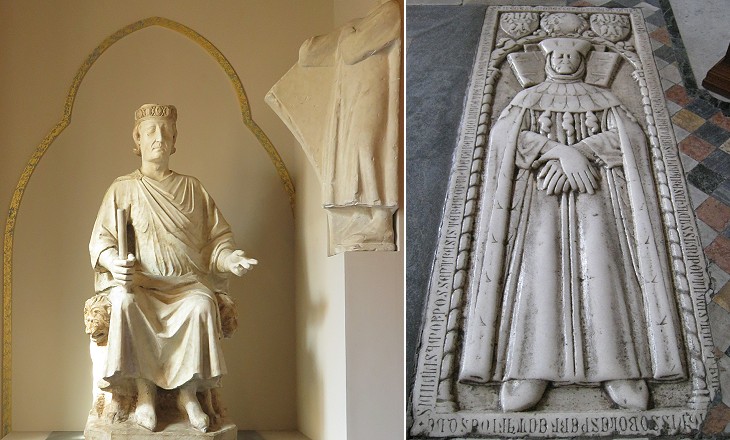
## (left) Statue of Charles of Anjou by Arnolfo da Cambio inside Palazzo dei Conservatori. He was appointed Senator of Rome in 1263, before he conquered the Kingdom of Naples; (right) gravestone of Pietro Lante di Pisa, Senator in 1380-1381 in S. Maria in Aracoeli
Eventually the popes managed to enforce their authority over the City of Rome and they turned the Senate into a body of their government system; for many centuries they appointed a Senatore di Roma who was assisted by four Conservatori; they had limited rights in matters such as markets, trade regulations and upkeep of streets and monuments. In the XVth century the popes continued to fortify Palazzo Senatorio: the two short wings which project from the fa�ade hide the towers built by Pope Martin V (left) and Pope Boniface IX (right). The palace was given an elegant appearance in the XVIth century; Michelangelo designed the twin staircases leading to the entrance, while the fa�ade was completed by Giacomo Della Porta, but the other three sides of the building retain the aspect of a fortress. The Senator of Rome, Count Rezzonico (nephew of [Pope Clement XIII](Storia27.html#Clement XIII)), had paid me a visit after his return from Germany (..). Though, as usual, I kept my distance, I was to be drawn inevitably into his circle (..) and I could not decline an invitation at a concert given in the Senator's residence on the Capitol (..). The sun was setting and the view of the Colosseum and its surroundings from the Senator's windows was magnificent (..). I had only to turn my head slightly to survey a vast panorama, lit by the glow of the setting sun. J. W. Goethe - Italian Journey - February 1788 - translation by W. H. Auden and E. Mayer - Collins 1962. You may wish to see a detail of a portrait of Rezzonico as Senator of Rome with a view of Campidoglio by Pompeo Batoni (it opens in another window).
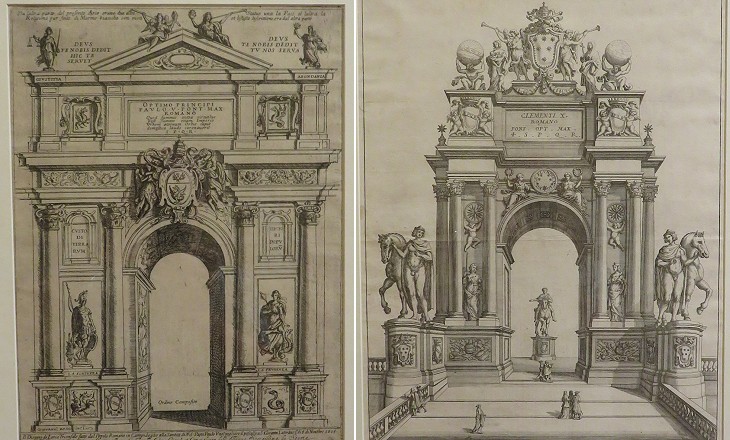
## Museo di Roma a Palazzo Braschi: ephemeral triumphal arches erected in Piazza del Campidoglio for the "possessio" of [Pope Paul V](Storia23.html#Paul V) in 1605 (left) and of [Pope Clement X](Storia25.html#Clement X) in 1670 (right). The latter was designed by Carlo Rainaldi together with a second arch at Orti Farnesiani
The decision to redesign Palazzo Senatorio and the square in front of it was taken by Pope Paul III as part of a diplomatic effort to improve relations with Emperor Charles V after the 1527 [Sack of Rome](Storia20.html#Clement VII). In 1535 Charles conquered Tunis and the Pope suggested celebrating this victory with a triumphal procession, similar to those of ancient Rome which ended on the Capitoline Hill. Michelangelo was charged with the development of an overall project which included making the access to the hill easier by opening a [new street](Vasi135.htm#The Plate) and building a ramp; as a matter of fact when the Emperor visited Rome in April 1536 very little work had been completed and the imperial procession did not access the top of the hill through the new ramp. Eventually the new piazza became the site where the Senator of Rome and the Conservatori paid their first homage to the newly elected pope. The Prince Giustiniani procured a place for us, at the Senator's house in the Capitol, from whence we might see the procession to the greatest advantage. On arriving, we were surprised to find the main body of the Palace, as well as the Palazzo de Conservatori, and the Museum, which form the two wings, all hung with crimson silk, laced with gold. The bases and capitals of the pillars and pilasters, where the silk could not be accurately applied, were gilt. Only imagine, what a figure the Farnesian Hercules would make, dressed in a silk suit, like a French petit-maitre. To cover the noble simplicity of Michael Angelo's architecture with such frippery by way of ornament, is, in my mind, a piece of refinement equally laudable. (..) At the entrance of the Capitol the Pope ([Pius VI in 1775](Storia28.html#Pius VI)) was met by the Senator of Rome, who, falling on his knees, delivered the keys into the hands of his Holiness, who pronounced a blessing over him, and restored him the keys. John Moore - A View of Society and Manners in Italy - 1781
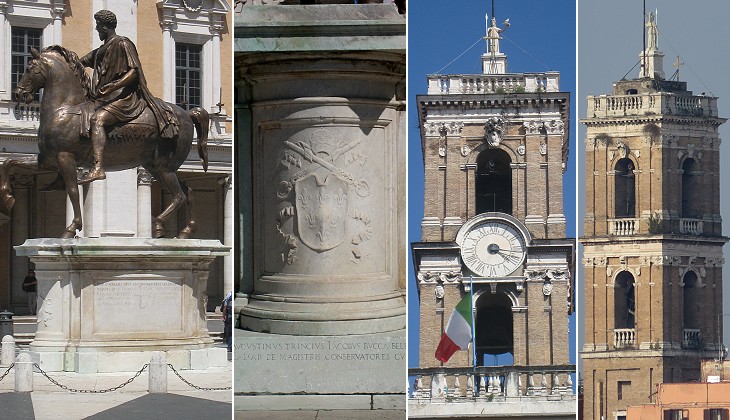
## (left) detail of a 1488 fresco by Filippino Lippi in Cappella Carafa inside S. Maria sopra Minerva showing the statue of Marcus Aurelius near the Lateran; (centre/right) pedestal designed by Michelangelo with the coat of arms of Pope Paul III
The Brasen Horse that is in the Capitol was found in a Vineyard near the Scala Sancta and S. John Lateran and lay neglected on the Ground for many Years, till Sixtus IV. was created Pope, who set it up in the Lateran Street on a handsome Marble Pedestal, with his own Arms and his Name carv'd on it. There it stood till the Days of Pope Paul III who caus'd the Horse to be removed into the Capitol, and a Pedestal for it to be adorned by Michael Angelo's own Hand. Flaminius Vacca's 1594 account of discoveries of antiquities which took place in his lifetime, as quoted in "The Travels of the Learned Father Montfaucon from Paris thro' Italy - 1712" The pedestal was carved out of a large marble block of the Forum by Michelangelo. It bears the coat of arms of Pope Paul III in the front and that of the City of Rome in the back. The statue was situated near Palazzo del Laterano and for many centuries it was known as Caballus Constantini and thought to represent Emperor Constantine; most likely this mistaken identity saved the statue from being melted; at the end of the XVth century it was recognized as a portrait of Marcus Aurelius and the pedestal bears his name in an inscription which imitates the classic ones. Many modern equestrian statues were modelled after that of Marcus Aurelius (e.g. those of Gran Duke Ferdinand I in Florence and of Emperor Joseph II in Vienna).

## (left) Drawing showing Palazzo Senatorio in ca 1550; (centre/right) Tower of Palazzo Senatorio
Palazzo Senatorio had a medieval bell tower which was located to the left of the entrance; in 1577 it was struck by lightning and it was rebuilt at the centre of the palace by Martino Longhi the Elder during the pontificate of Pope Gregory XIII.
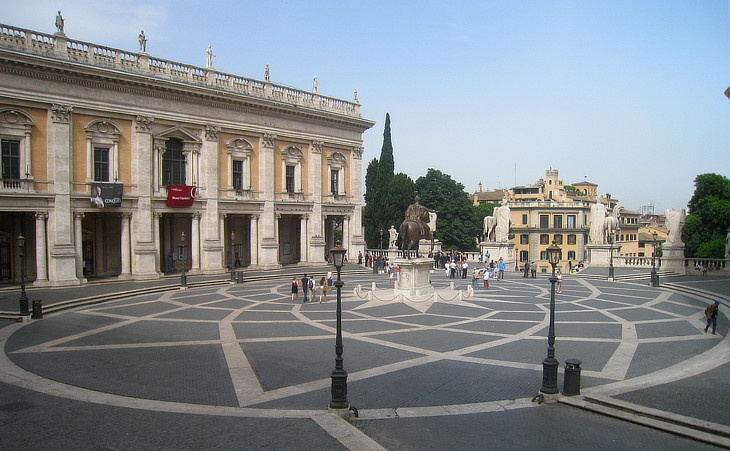
## Palazzo dei Conservatori and the decoration of Piazza del Campidoglio
Palazzo dei Conservatori was built in the XIIIth century to house some municipal offices and those of the guilds into which all economic activities were organized; in the XVth century it was rebuilt and it was assigned to the Conservatori, the officers appointed by the Pope to assist the Senator and who were so named because of their role in the conservation of the monuments of Rome. In 1563-1568 the palace was redesigned by Michelangelo and Giacomo Della Porta; the fa�ade is remarkable for its pilasters which span two stories, rather than one as in classical architecture (see for comparison Colosseo). As a matter of fact the use of a "colossal" order can be noticed in the Temple of Bacchus at Baalbek. This new pattern influenced the design of [Palazzo Chigi Odescalchi](Vasi64.htm#Palazzo Odescalchi) by Gian Lorenzo Bernini. Michelangelo planned to complete Piazza del Campidoglio with a third palace, similar to Palazzo dei Conservatori, in order to give the square a symmetrical aspect, i.e. that of an isosceles trapezium. His project, which we know from contemporary etchings, included inscribing an oval inside the square and having a star-like decoration starting from the statue of Marcus Aurelius; the oval is visible in the small 1748 map, while the star motif was completed only in 1940 (it can be seen in the Italian 50 cents Euro coin - it opens in another window).
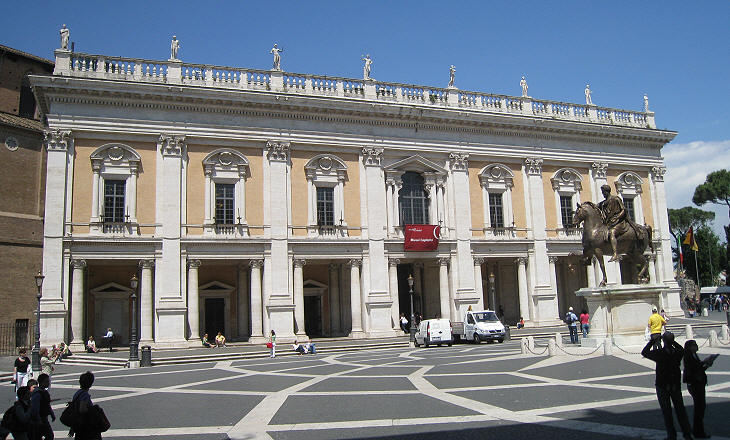
## Palazzo Nuovo
In Michelangelo's project the third palace should have had only an aesthetic purpose; Pope Paul III had a residence behind S. Maria di Aracoeli (its imposing tower can be seen in [another plate](Vasi65.htm#The Plate) by Vasi) and the balcony of the new palace could have been used for blessings. With the death of the Pope in 1549 the interest for this building subsided; a century later municipal authorities promoted its completion during the pontificate of [Pope Innocent X](Storia24.html#Innocent X). The interior was designed by Girolamo and Carlo Rainaldi while the fa�ade is similar to that of Palazzo dei Conservatori. The new palace did not have a specific purpose until 1734 when [Pope Clement XII](Storia27.html#Clement XII) turned it into a museum to house the (second) Albani collection of antiquities (more on this topic in a page covering Villa Albani).
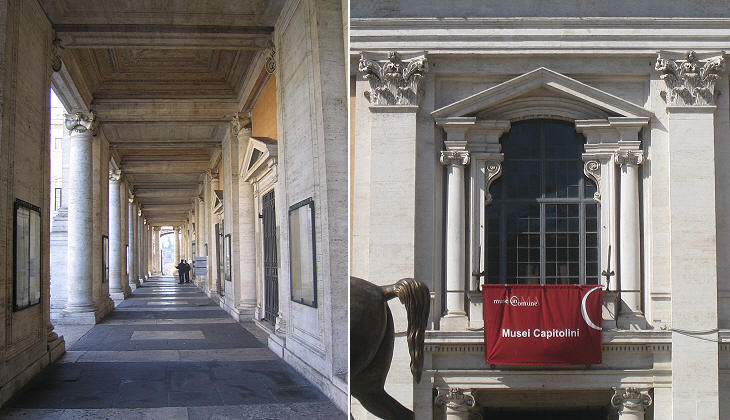
## (left) Portico of Palazzo dei Conservatori; (right) central window of Palazzo Nuovo
Today Palazzo Nuovo, Palazzo dei Conservatori and the Tabularium beneath Palazzo Senatorio are linked by an underground passage and they make up Musei Capitolini.
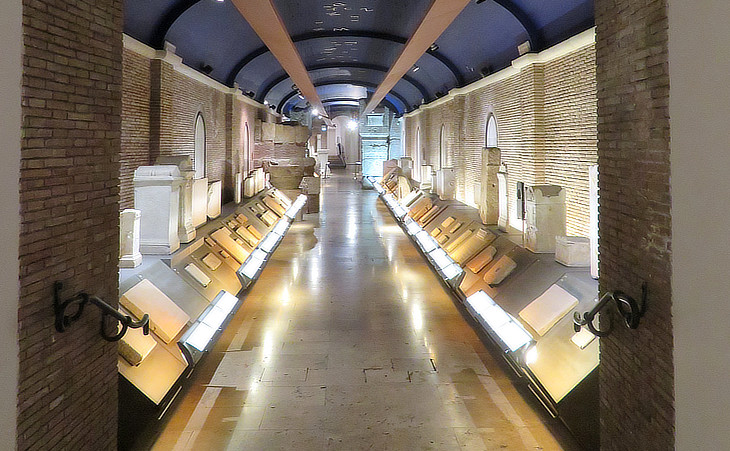
## Musei Capitolini: The Epigraphic Gallery (Galleria Lapidaria), underground passage connecting Palazzo Nuovo and Palazzo dei Conservatori and giving access to the Tabularium
#### Ancient Statues
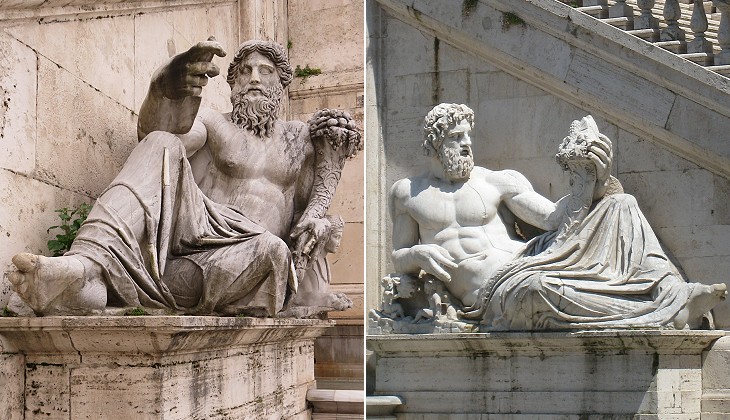
## (left) The River Nile; (right) the River Tiber
The ancient Romans made use of chairs, but not to sit at a dining table; for their dinners they lay on couches in a position very similar to that exemplified by the two ancient statues of river gods which Michelangelo placed in front of Palazzo Senatorio. They portrayed the Nile and the Tigris; the latter however was turned into the Tiber by adding the she-wolf with Romulus and Remus (see the image used as background for this page). They most likely decorated the baths which Emperor Constantine built on the site of today's [Palazzo Rospigliosi](Vasi62.htm#The Plate), where they were found, but, as they are dated IInd century AD, they were originally made for another monument. You may wish to see two other ancient statues of the Nile and of the Tiber which were found at Iseo Campense.

## Statues of Castor and Pollux (they were identical twins)
I remember that near the Tiber where now the Synagogue of the Jews stands, in the Days of Pope Pius IV, two Giants were dug up, each of them leading a Horse. They were remov'd to the Capitol and now stand on the top of the Stairs, at the end of the Street. Some said they were two Pompeys; others, because they have Hats or Caps on their Heads, in the shape of half an Egg, thought they were Castor and Pollux; others fancy'd other things. Vacca In Michelangelo's project the access to Piazza del Campidoglio should have been flanked by the statues of Castor and Pollux in Piazza del Quirinale; when eventually in 1578 Giacomo Della Porta built the balustrade which closes the square two facts had occurred which led to a change: a) the popes had started to build their palace on the Quirinale Hill and they were unwilling to deprive that location of the two famous statues; b) in 1561, during excavations associated with the construction of the [walls of the Ghetto](Vasi29.html#The Plate), several fragments of two gigantic statues of Castor and Pollux were found; these fragments complemented other parts which had been found in previous years. Pope Gregory XIII decided to utilize these statues for the decoration of Piazza del Campidoglio; all the pieces were assembled and a team of sculptors worked at their restoration; in 1582 the statues were placed on pedestals similar to that designed by Michelangelo for Marcus Aurelius; the head of the statue on the left was made at that time as the original head was not found.
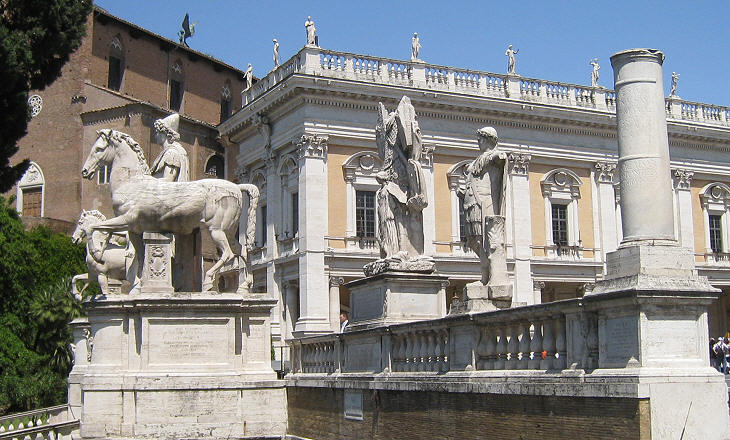
## Southern section of the balustrade with (left to right) one of the two "Trophies of Marius", a statue of Emperor Constantine and the column marking the first mile of Via Appia. The northern section has a similar decoration
I remember, that at the foot of the Tarpeian Hill, towards Marcellus's Theatre, there was found the Columna Miliaria which now stands in the Street of the Capitol; and it had been put into some Building where found. Vacca These Pillars, Statues, and Trophies, by their being Severally of a like height on each side, and different one from the other, have a Beautiful Effect. Jonathan and Jonathan Richardson - Account of Some of the Statues, etc. in Italy - 1722 In the XVth century a high number of statues were unearthed in the ruin of the ancient Roman monuments; some of them were used by the popes to embellish their residences (e.g. Casino del Belvedere), others were assigned to the City of Rome (the first ones by Pope Sixtus IV in 1471); it is difficult to identify the guidelines followed by the popes in their decisions; it can be said that the statues housed in Musei Capitolini are mainly related to figures/events of the history of Rome. In 1590 [Pope Sixtus V](Storia23.html#Sixtus V) placed the "Trophies of Marius" which decorated a gigantic fountain near S. Eusebio on the balustrade of Piazza di Campidoglio; in 1653 Pope Innocent X added the statues of Emperor Constantine and of his son Constantine II; the column marking the first mile of Via Appia was added in 1692; the column on the northern section of the balustrade was found at the seventh mile in 1848.

## (left) One of the two "Trophies of Marius" (you may wish to see some details of it); (centre) personification of Rome (late Ist century AD); (right) Centrale Montemartini: statue of Diana which stood on the bell tower until 1870. It held a large cross and it was a personification of Christian Rome
Michelangelo planned to place a large statue of Jupiter between the statues of the two rivers; eventually a standing statue of Minerva was placed in the niche, but when a fountain was built at the end of the XVIth century, it was replaced by a smaller seated statue of Minerva which was modified in order to portray a personification of Rome.
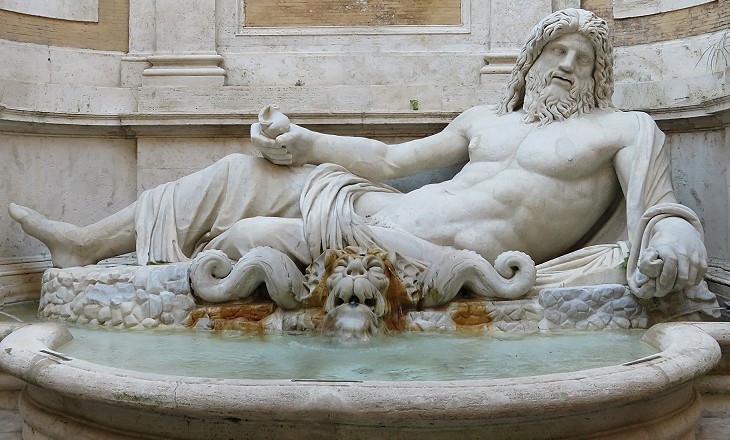
## Marforio (in the courtyard of Palazzo Nuovo)
Marforio, a Colossal Figure of a River, well enough preserv'd, and of a great Taste, the Head especially. Richardson In 1595 the colossal statue of a river god (or Neptune) situated at the [foot of the hill](Vasi35a.htm#The Plate) was relocated to Piazza del Campidoglio; it was known as Marforio and it was one of the talking statues of Rome (Pasquino, Madama Lucrezia, Abate Luigi, il Facchino andil Babuino, in addition to Marforio). The decision to relocate the statue was most likely aimed at monitoring the satires which were hung on it. The statue was moved inside Palazzo Nuovo in 1679. It is dated early Ist century AD, but there is uncertainty about the river it represents.
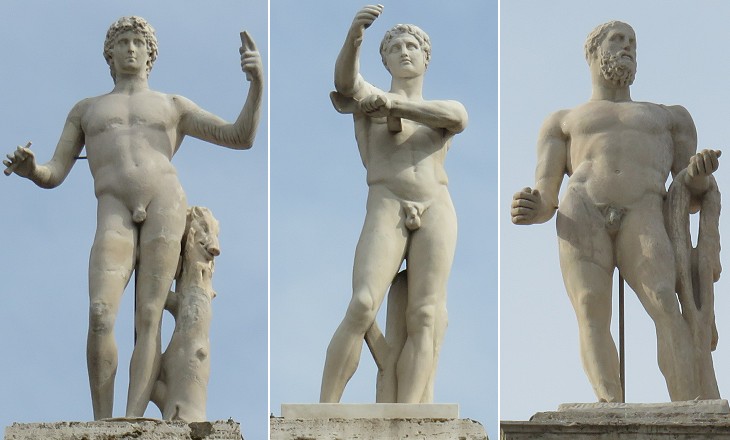
## Statues on the balustrades of Palazzo Nuovo and Palazzo dei Conservatori: (left to right): Meleager and the head of the Calydonian Boar, Apoxyomenos (Scraper) and Hercules. They were donated by [Pope Pius V](Storia22.html#Pius V) in 1566 and placed on the balustrades at a later time
The balustrades of Piazza S. Pietro are decorated with 140 statues of saints, but in Piazza del Campidoglio the balustrades of the three palaces have only two statues of saints (St. Peter and St. Paul). All the other statues depict pagan heroes and gods. It is hard to classify them as ancient statues because they were largely restored and their missing parts were replaced by new ones.
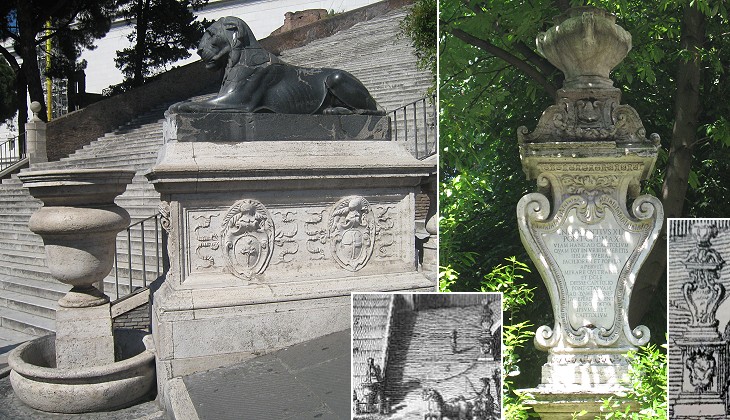
## (left) Egyptian basalt lion (from Iseo Campense) at the beginning of the ramp; it poured water into a basin (see a similar statue at Cortile della Pigna). The coats of arms are those of the Conservatori in charge in 1582; (right) monument bearing the heraldic symbols of [Pope Innocent XII](Storia26.html#Innocent XII); (insets) details of the plate showing the lion and the little monument
In antiquity the hill was accessible only from the Roman Forum. The steps leading to the church of S. Maria in Aracoeli were built in 1348 by Cola di Rienzo to celebrate the end of the Black Death, a particularly violent pestilence. The ramp leading to Piazza del Campidoglio is commonly attributed to Michelangelo, but it was actually modified and completed by Giacomo Della Porta in 1578. The plate by Vasi shows a small monument to the right of this ramp. It celebrates the opening of a second less steep ramp; it has three pots on its top, the heraldic symbols of Pope Innocent XII Pignatelli (pignatta means pot). The monument is now relocated along the modern winding street which allows cars to reach Piazza del Campidoglio.
#### Palazzo Caffarelli
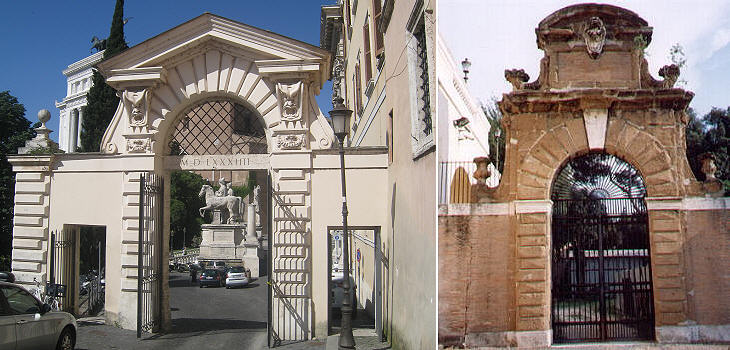
## (left) 1584 portal leading to Palazzo Caffarelli; (right) reassembled gate of Villa Della Rovere near Porta Salaria which was relocated to the eastern side of Palazzo Caffarelli in 1926
The Caffarelli are chiefly known because of Cardinal Scipione Caffarelli, nephew of Pope Paul V Borghese, who added his uncle's surname to his own. Giovanni Pietro I Caffarelli who served as page to Emperor Charles V during his Roman visit was rewarded with a piece of land behind Palazzo dei Conservatori; his son Ascanio started to build a family palace which was accessed through a portal from Piazza di Campidoglio; the palace was completed in 1610 by Giovanni Pietro II who celebrated the achievement with an inscription and a coat of arms which are now placed on a terrace in front of the palace, the fa�ade of which has lost its Renaissance appearance.

## (left) Modern terrace in front of Palazzo Caffarelli (you may wish to see some views from this terrace); (right) inscription and coat of arms of Giovanni Pietro II Caffarelli
In the XIXth century Palazzo Caffarelli became the German Embassy and it was adapted to its new function. It was confiscated at the end of World War I and again modified in order to enlarge Musei Capitolini.
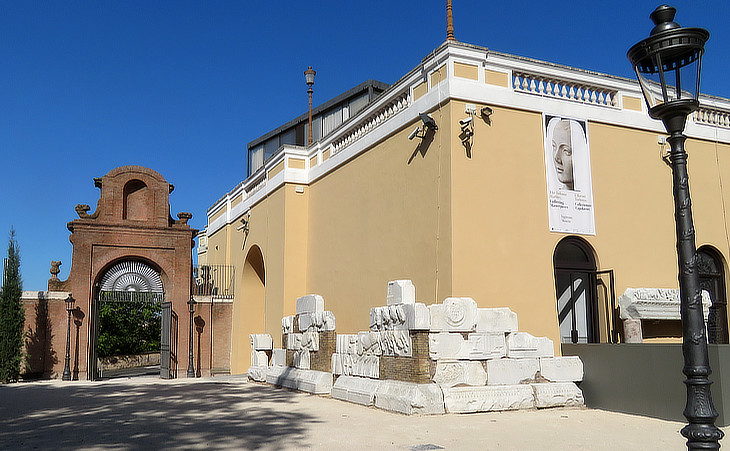
## Inner garden and premises of Palazzo Caffarelli which house temporary exhibitions (in October 2020 sculptures from the [Torlonia Collection](Vasi190.htm#Museo Torlonia)); on the wall Monument to Publius Aelius Gutta Calpurnianus and fragments of other monuments which were found outside [Porta del Popolo](Vasi01.htm#The Gate)

## Small statues and capitals which were placed in the Caffarelli Garden in the 1920s: see a bronze statue of a drunken satyr from Herculaneum
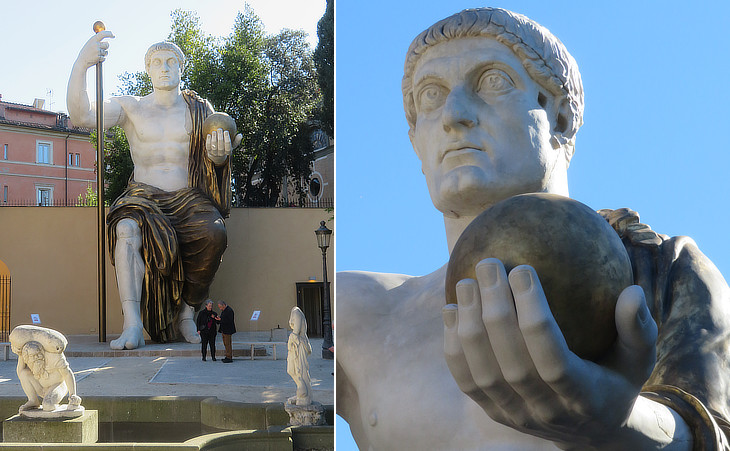
## February 2024: temporary exhibition of a modern reconstruction of a colossal statue of Emperor Constantine at Giardino Caffarelli
#### Tempio di Giove Capitolino and Triade Capitolina
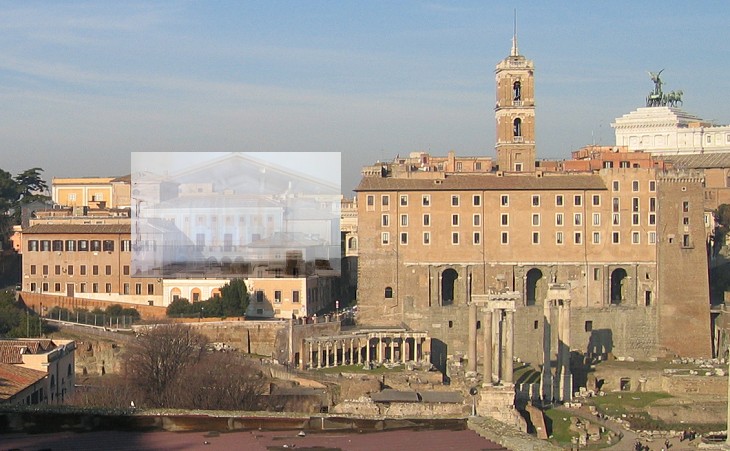
## View of the Capitoline Hill from the Palatine showing the approximate location of Tempio di Giove Capitolino (lighter section) behind Palazzo dei Conservatori: it faced the [Roman Forum](Vasi31.htm#The Plate)
Tarquinius, with prophetic anticipation of the splendour which the place was one day to possess, laid foundations for the temple of Jupiter on the Capitol, which he had vowed in the Sabine war. Livy - The History of Rome - Book I - translation by Benjamin Oliver Foster The construction of the temple required a major effort to create a terrace on the rough and uneven surface of the hill and the structures which supported it are its only remaining evidence; it was destroyed by fire at the time of Silla and again at that of Emperor Vespasian. Triumphal processions ended with a ceremony at this temple. Its appearance can be guessed in two reliefs which decorated an arch to Marcus Aurelius.

## Exhibition at Scuderie del Quirinale: Triade Capitolina from Montecelio (IInd century AD) (see other images of the statues)
In the centre of the temple, with Juno on his left, and Minerva, on his right side, the Thunderer sat on a throne of gold, grasping the lightning in one hand and in the other, wielding the sceptre of the universe. John Chetwode Eustace - A Classical Tour through Italy in 1802 Juno and Minerva were worshipped with Jupiter thus forming the Capitoline Triad to whom temples (Capitolia) were dedicated in almost all towns of the Empire, from Thugga in Tunisia to Scarbantia in Hungary. Usually statues of the three deities were placed into separate niches (or small temples e.g. at Sufetula); a statue portraying the three deities together was found in the 1990s in the environs of Rome and perhaps it is a small scale copy of that in the Capitoline temple. It depicts also the birds which were sacred to the deities: owl (Minerva); eagle (Jupiter) and peacock (Juno).

## Underground structures supporting the cella (left) and the portico (right) of Tempio di Giove Capitolino near Esedra di Marc' Aurelio inside Musei Capitolini
#### Uffici delle Corporazioni
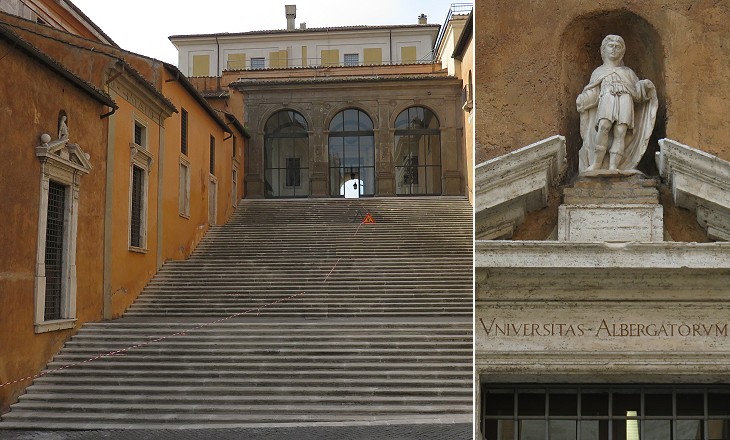
## (left) Staircase from Piazza del Campidoglio to Portico di Papa Giulio III; (right) small statue of St. Julian the Hospitaller, patron saint of the Roman owners of inns
A portico and a staircase were built in 1550-1553 on the south-eastern side of Palazzo dei Conservatori. They are almost identical to those which led to Convento di S. Maria in Aracoeli in the opposite section of Piazza del Campidoglio. The ground floor of Palazzo dei Conservatori and the building to the left of the staircase housed the offices of the most important guilds of Rome.

## (left) Office of the carpenters' guild at Palazzo dei Conservatori; (centre) symbols of the tailors' and builders' guilds; (right) symbols of the greengrocers', bakers' and pharmacists' guilds
Guilds were part of the economic system of Ancient Rome and their importance is particularly evident at Ostia where some temples were built by guilds (e.g. that of ship carpenters and that of grain measurers). They had even more relevance in Rome between the XVIth and the XVIIIth century. All activities were reserved to members of a guild, and guilds could be as small as having four members, according to records of 1708. All guilds had a church or a chapel dedicated to their patron saint.

## Former location of the Guild of the Tailors and Merchants: fresco by Antoniazzo Romano (late XVth century) portraying the Virgin Mary, St. Peter and St. Sebastian, patron of tailors
#### Palazzetto Altemps

## Reassembled fa�ade and details of Palazzetto Altemps
The buildings opposite the southern side of Palazzo Senatorio were modified in the 1920s to provide room for some new offices needed by the City of Rome. One of these new buildings was decorated with the fa�ade of Palazzetto Altemps, a small casino located near [Porta del Popolo](Vasi01.htm#The Gate)which was pulled down to enlarge Via Flaminia. The fa�ade, designed by Onorio Longhi in 1600, has many references to the heraldic symbol of the Altemps, a rampant ram. The Altemps had a very elegant palace in town, which was built by Cardinal Marco Sittico Altemps, nephew of [Pope Pius IV](Storia22.html#Pius IV).
#### Rupe Tarpea

## Rupe Tarpea seen from S. Maria della Consolazione (you may wish to see a 1909 watercolour by Yoshio Markino showing the houses which were demolished in the 1930s)
Every school-boy has read with delight Virgil's short, but splendid description of this hill (Aeneid VIII), then a silvan scene of dark forest and craggy rock though destined one day to become the seat of regal opulence and universal empire. "Hinc ad Tarpeiam sedem, et Capitolia ducit Aurea nunc, olim sylvestribus horrida dumis. Jam tum Relligio pavidos terrebat agrestes Dira loci Jam tum sylvam saxumque tremebant." He leads him to the Tarpeian rock and the Capitol now of gold but in those days rough and horrid with wild bushes. Even then the religious horrors of the place awed the minds of the timorous swains, even then they revered the wood and rock (1811 translation). Every circumstance that could dignify and consecrate the spot, and prepare it for its grand destiny, is here collected by the poet, and gradually expanded with wonderful art, while a certain awful obscurity hangs over the whole, and augments the magnitude of the object thus dimly presented to the fancy. Eustace Tarpea is the name of a legendary young woman who opened the doors of the Roman Arx (the citadel on the peak of the hill where today S. Maria in Aracoeli is located) to the Sabines; in return for her treason the Sabines first buried her under their shields (see a relief at Basilica Aemilia) and then threw her body from a rock of the other peak which has been called Rupe Tarpea (Tarpeian Rock) since then. The ancient Romans executed traitors in a similar way; the exact site where these executions took place was debated for a long time; eventually a precipice on the southern side of the hill has been identified as the most likely location for Rupe Tarpea. The Tarpeian rock is divided, by the beggars who inhabit the cottages, between the two angles towards the Tyber; the highest is that called [Monte Caprino](Vasi177.htm#Portico di Monte Caprino), behind the gallery of the Conservators' palace and the palazzo Caffarelli; the most abrupt is the corner at the other end of the same Conservators' palace. Which of these two is the actual precipice whence the traitors were thrown, has not been, yet resolved. Hobhouse
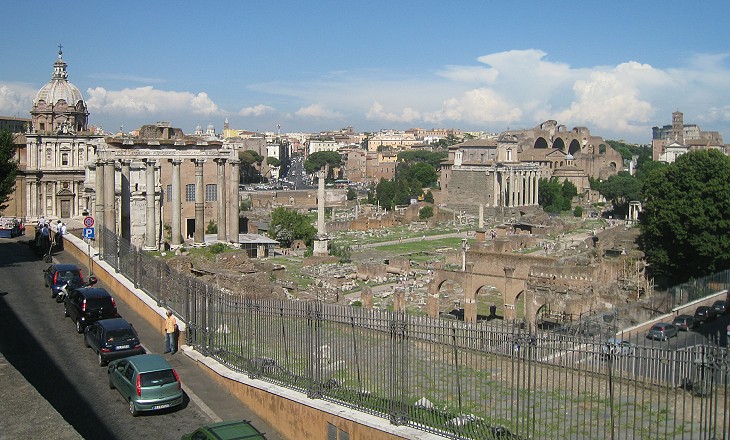
## The Roman Forum from Rupe Tarpea
What a beautiful view of the city - exclaimed Hilda - and I never saw Rome from this point before! It ought to afford a good prospect - said the sculptor - for it was from this point - at least we are at liberty to think so, if we choose - that many a famous Roman caught his last glimpse of his native city, and of all other earthly things. This is one of the sides of the Tarpeian Rock. Look over the parapet, and see what a sheer tumble there might still be for a traitor, in spite of the thirty feet of soil that have accumulated at the foot of the precipice. Nathaniel Hawthorne - The Marble Faun - 1860
Move to page two and visit the interiors of Palazzo dei Conservatori and Palazzo Nuovo and the Epigraphic Gallery.
You have completed Book 4! Move to Book 5: [Ponte Mammolo](Vasi81.htm#The Plate). Next step in Day 1 itinerary: [Campo Vaccino](Vasi31.htm#The Plate). Next step in your tour of Rione Campitelli: [Campo Vaccino](Vasi31.htm#The Plate).
Excerpts from Giuseppe Vasi 1761 Itinerary related to this page:
###### [Campidoglio, e suoi Palazzi](#The Palaces)
##### Gi� dicemmo, che questo Colle fu detto Saturnio da Saturno, che da principio lo abit�. In tempo di Romolo fu chiamato Rocca, o vogliamo dire fortezza; ben � vero per�, che come fra poco diremo, la Rocca fu quella parte, che guarda il Tevere. Si disse ancora Capitolino per un teschio di corpo umano trovato nel fare i fondamenti del divisato tempio di Giove. Ora per� lo diciamo Campidoglio, e sebbene da prima avesse solamente l'accesso nel clivo verso mezzo d�, dopo che i Romani passarono ad abitare il campo Marzio, fu aperto anche il clivo verso tramontana. Il gran Pontefice Paolo III. fu quello, che dopo aver aperta la strada d'incontro, fece ancora con disegno del Buonarroti la magnifica scala a cordonata fiancheggiata di balaustri. Le due Lionesse di marmo egizio, che buttano l'acqua nelle fontane, che sono nel principio della scala, furono del tempio d'Iside, ed il tronco della statua, che si vede fatta in porfido, viene creduta una Roma. Li due gran colossi, che si vedono nel termine della scala rappresentano Castore, e Polluce co' loro cavalli, e li due gran trofei di marmo uno a destra ed altro a sinistra sono quei di Mario; le due statue sono di Costantino magno, e le due colonne, una � la migliaria rifatta dall'Imp. Vespasiano, e quanto all'altra dicesi, che nella sua palla stessero le ceneri di Trajano. In mezzo alla piazza si vede la statua equestre di metallo corintio rappresentante Marco Aurelio, che fu trovata nelle vigne presso le Scale Sante in tempo di Pio IV. e per qualche tempo stette alzata sulla piazza della Basilica Lateranense, ma poi da Paolo III. quivi fu posta sopra un gran piedistallo fatto dal Buonarroti. Si crede dagli Antiquarj, qu� presso essere stato il celebre Asilo, o rifugio eretto da Romolo per popolare la sua Citt�. I tre palazzi, che circondano questa piazza appartengono al Magistrato Romano, e furono li due laterali ornati con portici interni ed esterni secondo il disegno del Buonarroti. Quello a sinistra fu da Clem. XII. destinato per una galleria di statue, busti, bassirilievi, e altre cose antiche, perci� ora � talmente pieno di marmi rari, e maravigliosi, che difficilmente potrebbesi qui tutti accennarli. Prima di trapassare il gran cancello di ferro, si vede in fondo del cortile la statua di Marforio a giacere per ornamento del fonte, e nelle nicchie laterali due satiri antichi; sotto li portici sonovi due statue della prima maniera egizia, altre in marmo bianco, ed un tripode maraviglioso. A piedi delle scale evvi la statua di Pirro, ed una colonna di alabastro diafano; nelle pareti delle scale si vede distribuita la pianta dell'antica Roma delineata in marmo, dono prezioso del mio Sovrano il Re delle due Sicilie, ed ora invittissimo Monarca delle Spagne Carlo III. Salire le scale si vedono altre statue, bassirilievi, e busti insigni; ma nelle stanze vi si trovano tante, e tante belle maraviglie, che gi� ne sono dati alla luce due tomi in foglio con una erudita descrizione, onde riuscirebbe meglio al mio lettore d'impiegarci una mezza giornata, che dal Custode li faranno tutte individuate a sufficienza. Il palazzo di mezzo, in cui risiede il Senatore di Roma, fu architettato da Giacomo del Duca Siciliano allievo del Buonarroti: di questo � per� il disegno della scala a due branchi, ed il fonte colla statua di Roma a sedere fatta di porfido, e col fiume Nilo, e Danubio a lato. Nella gran sala si vedono le statue di Carlo d'Angi� Re di Napoli e Senatore di Roma, quella di Paolo III. e di Greg. XIII. il quale alz� sopra di questo palazzo la nuova torre con due grosse campane, che a martello danno il segno, una per i consigli generali, e l�altra per l'udienze del Tribunale Capitolino, perci� nel ballo vi sono le carceri. Nel palazzo a destra si raduna, e tiene tribunale il Magistrato Romano, e per� le stanze, che sono sotto i portici furono destinate per radunarvi i Consoli delle arti. Entrando poi nel cortile di quello, si vede in primo luogo a destra la statua di Giulio Cesare, e a sinistra quella di Ottaviano Augusto. In fondo del cortile medesimo, e sotto i portici fatti dal Buonarroti si vede assisa la statua di Roma, e nel suo piedistallo si ravvisa in bassorilievo la Dacia soggiogata da' Romani; a destra, e a sinistra due Re prigionieri lavorati mirabilmente in marmo nero pi� grandi del naturale, e d'intorno al cortile evvi una testa di marmo, ed altra di metallo, con mani e piedi grandi assai pi� del naturale, e varie altre antichit�. Nel principio della scala evvi la colonna rostrata, eretta per trofeo a C. Duillio per aver egli il primo trionfato in guerra navale contro i Cartaginesi. Vedesi ancora un basso rilievo rappresentante Curzio, che si precipita nella voragine; dipoi un leone in marmo, ed una statua di Musa, con altre due nel primo riposo. Si vedono ancora nel cortile pensile li 4. bassirilievi, che erano nel arco di Trajano: Nell'appartamento poi sonovi delle pitture, e statue di marmo, e di metallo, antiche, e moderne; onde per non aggravare il mio Lettore lo rimetto al Custode, che gentilmente li mostrer� tutto. Evvi appresso una galleria di quadri celebri, ed insieme lo studio, o accademia del disegno, ambedue eretti dal Pontefice Benedetto XIV. in vantaggio delli studiosi.
###### Palazzo Caffarelli sulla rupe Tarpea
##### Accanto al divisato palazzo verso ponente, � quello della nobilissima famiglia Caffarelli, e per quanto appare siede sulla rupe Tarpeja, poich� in niuno altro luogo si vede segno di rupe, come in quello riguardante il teatro di Marcello, appunto come si dice da Livio, da Plutarco, e da tanti altri. Si disse Tarpeja per una vergine Sabinese, che da quella parte introdusse i nemici nella Rocca: ora si dice monte Caprino, perch� essendo disabitato ne' secoli andati vi si tenevano le capre; ben � vero per� che ci� s'intende per il sito dall'altra parte verso mezzo d�, in cui sin al Pontificato d'Innocenzo VIII., che fu del 1484 vi si eseguiva la giustizia.